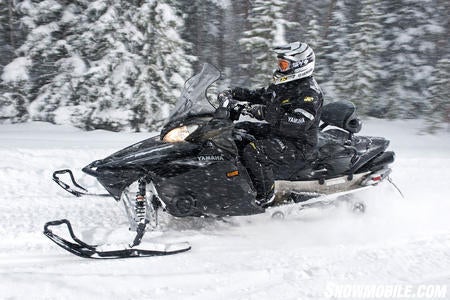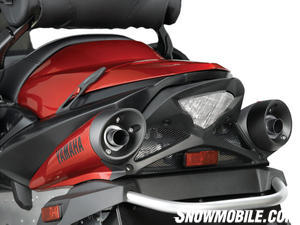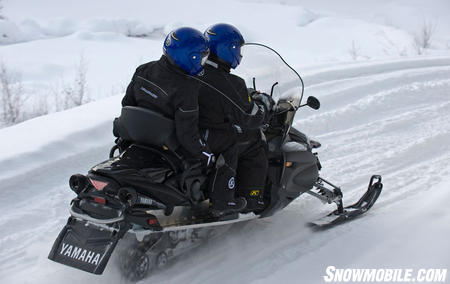For 2009, Yamaha reinvents its Nytro with an extended track version that offers vastly improved ride and handling. Wisely, the power train remains virtually the same.
The facts are simple. Sitting under the steering post of the virtually all-new Nytro XTX, you'll find the same fuel-injected Yamaha Genesis 130 as last year. Expect smoother running and even quicker response as Yamaha engineering has had a full season of fine-tuning this snowmobile-specific triple. The drive system reflects updated tuning refinements to match the power delivery to an all-new extended chassis and track dynamic. Gone is the 121-inch Rip Saw track, replaced by a longer 144-incher with the same
1.25-inch height lugs.
 In an on-trail riding comparison of the new Nytro XTX with the "144" track and a 2008 specification Nytro with '121' Camoplast Rip Saw, the new XTX definitely seemed to like delivering power better through the longer track. While you can still get track spin on the 144 when you slam the throttle flipper from half to full throttle, the extended track length provides better on-trail control. The shorter track would spin and torque to the side more like a car's tires on ice when you floor the gas pedal. The other advantage of the longer track comes in the 'bridging' effect you get over stutter bumps and increased flotation when breaking trail in fresh powder.
In an on-trail riding comparison of the new Nytro XTX with the "144" track and a 2008 specification Nytro with '121' Camoplast Rip Saw, the new XTX definitely seemed to like delivering power better through the longer track. While you can still get track spin on the 144 when you slam the throttle flipper from half to full throttle, the extended track length provides better on-trail control. The shorter track would spin and torque to the side more like a car's tires on ice when you floor the gas pedal. The other advantage of the longer track comes in the 'bridging' effect you get over stutter bumps and increased flotation when breaking trail in fresh powder.
 The upgrade from 121 to 144-inch track blows right past the use of the 136-inch track found in the LTX versions of both the Apex and Vector. The reason for the longer track lies in the new XTX sled's closer relationship with th
The upgrade from 121 to 144-inch track blows right past the use of the 136-inch track found in the LTX versions of both the Apex and Vector. The reason for the longer track lies in the new XTX sled's closer relationship with th
e mountain Nytro than the trail Nytro. Still, the 144-inch track is shorter than the Nytro MTX's 153-inch deep powder track setup.
Why did Yamaha settle on the 144? Primarily because the sled's designers felt that they could devise a new rear suspension that would provide the handling attributes of a 121 on groomed trails, the bridging comfort ability of a 136 and the added deep snow float of a 144. To gain this combination required a major rethinking of the hybrid sled's suspension. That's why you'll find what Yamaha refers to as the XTX's "...aggressive 6-degree rear tip-up on the rails." The footprint on hard-packed groomed trails will be that of a 121-inch tracked sled, meaning you feel the sporty cornering characteristics you'd expect from the 2008 Nytro. In reality, we liked the new Nytro XTX better than the old short-track version. However, there's more to all of it than a revised rear end.
Up front counts

In our opinion, the XTX shows enhanced cornering due to a redesign of the front suspension. The rear end is also an improvement. However, the concept of tip-up slide rails is not new. Polaris has been there in the past and Arctic Cat has used a tipped up rail on some touring and utility sleds. The advantage is real and you will recognize it, especially when you use reverse and the track doesn't mire itself into the snow. No, for us, the real advantage to the XTX over the previous Nytro is up front. Think of this sled as what it is - a totally new platform for a very potent existing power system. Yamaha does not so much obsolete the 2008 Nytro as it creates a whole new level of sports performance with a new tunnel and chassis. Still aluminum, the 2009 tunnel flips up at the back a full 11-degrees to give vastly improved powder capability. That's why we say the XTX has more in common with the mountain Nytro than the 2008 base model. There are more and larger holes in the runningboards that not only allow better snow evacuation when riding off trail, but add improved bite for your boots to keep you in contact with the XTX.
That new front end borrows from the snocross world and settles the sled way better than previous Nytro front designs. Yamaha claims that the new front end slows down the steering. Is that an admission that last year's Nytro was extremely nervous when pushed hard in the corners? Whatever. The new design feels lower and more responsive due to added trail and revised caster angles. The new front end relies on Yamaha's own GYTR dual clicker shocks which we've found to be easy to adjust on trail. There are 12 compression settings and 20 rebound adjustments, meaning that it is critical that owners read the setup manual. You'll find a set of high-pressure gas shocks in the rear suspension: a 40mm remote reservoir shock with compression 'clicker' on the front arm combined with an aluminum-bodied HPG rear shock.
New and improved
We found the XTX a great improvement over the previous Nytro. The handlebar set fits the rider better with its one-piece design incorporating curved bar ends. The bar sits taller and combined with the upgraded front suspension you have better leverage and, thus, better control on the trail. The XTX expands the concept of rider-forward positioning first seen on the Apex series. While borrowing from snocross, the XTX gives an immediacy desired in the deepest powder of the mountains. You sit on a new and narrower sculpted seat that has you nearly upright so you can rise quickly to react to changing terrain if you go off trail. For trail riders, you can more quickly rise to meet those bad ditch moguls and for groomed riders you can move side to side more easily to time quick twists in the trail.
With all that's new about the XTX, Yamaha surprisingly said little about weight. Comparing the published specifications for the new XTX we find a claimed weight of 542-pounds. That's more than 20-pounds greater than last season's Nytro RTX with reverse and about the same as a 2008 Nytro MTX (5







































